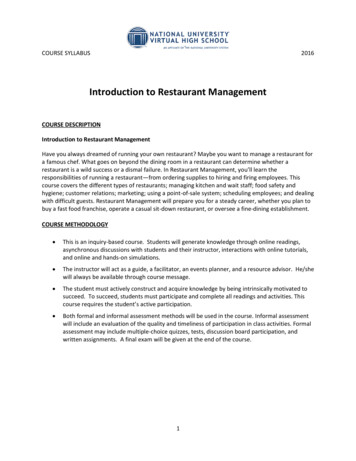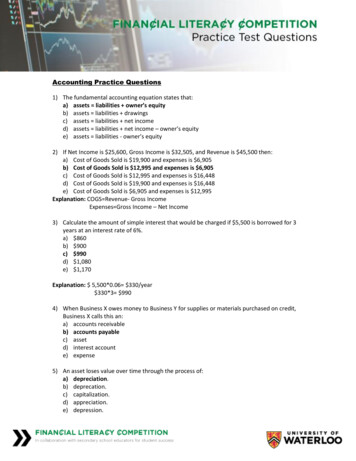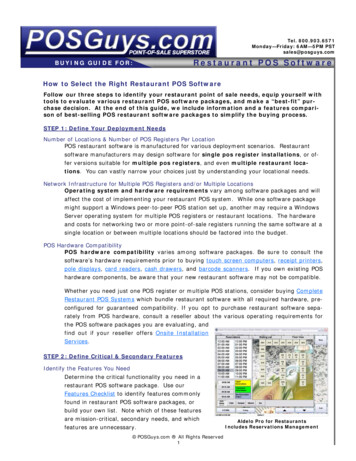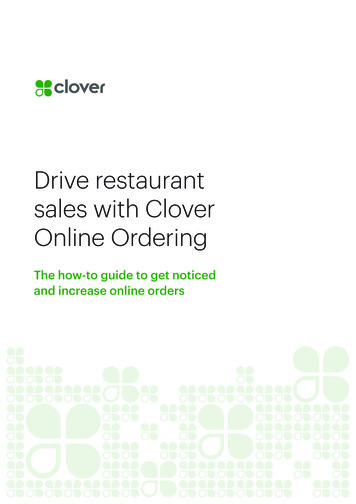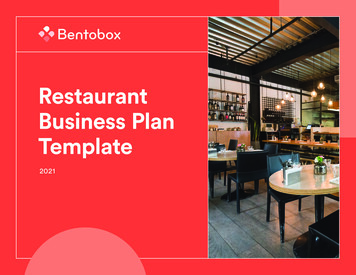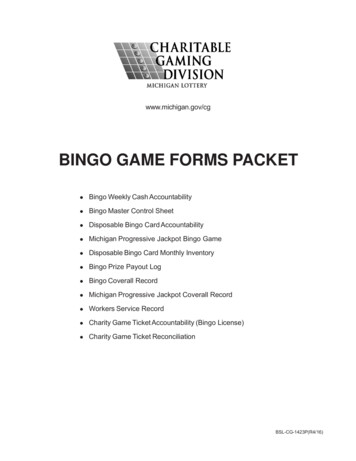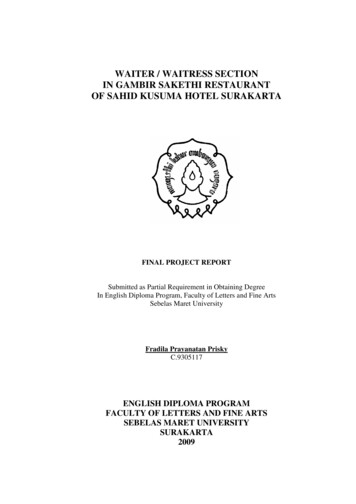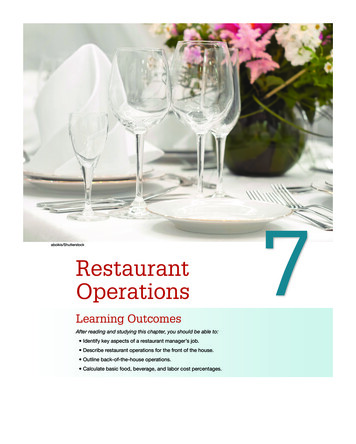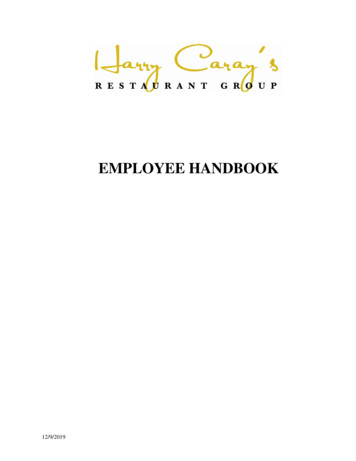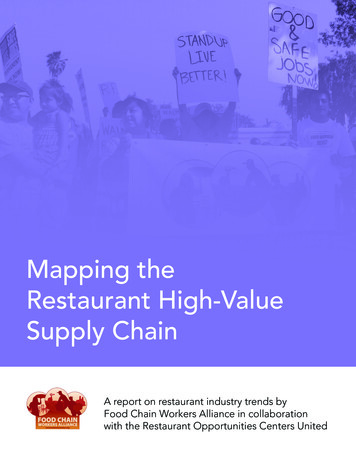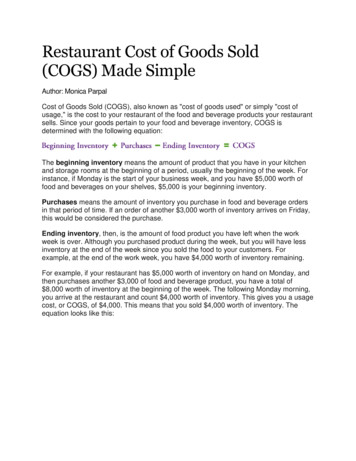
Transcription
Restaurant Cost of Goods Sold(COGS) Made SimpleAuthor: Monica ParpalCost of Goods Sold (COGS), also known as "cost of goods used" or simply "cost ofusage," is the cost to your restaurant of the food and beverage products your restaurantsells. Since your goods pertain to your food and beverage inventory, COGS isdetermined with the following equation:The beginning inventory means the amount of product that you have in your kitchenand storage rooms at the beginning of a period, usually the beginning of the week. Forinstance, if Monday is the start of your business week, and you have 5,000 worth offood and beverages on your shelves, 5,000 is your beginning inventory.Purchases means the amount of inventory you purchase in food and beverage ordersin that period of time. If an order of another 3,000 worth of inventory arrives on Friday,this would be considered the purchase.Ending inventory, then, is the amount of food product you have left when the workweek is over. Although you purchased product during the week, but you will have lessinventory at the end of the week since you sold the food to your customers. Forexample, at the end of the work week, you have 4,000 worth of inventory remaining.For example, if your restaurant has 5,000 worth of inventory on hand on Monday, andthen purchases another 3,000 of food and beverage product, you have a total of 8,000 worth of inventory at the beginning of the week. The following Monday morning,you arrive at the restaurant and count 4,000 worth of inventory. This gives you a usagecost, or COGS, of 4,000. This means that you sold 4,000 worth of inventory. Theequation looks like this:
Adding Transfers to the NumbersTo be even more accurate, you can use the equation below:"Transfers out" include any products that you send out of the restaurant to another areain your restaurant (such as from the bar to the kitchen) or to another restaurantaltogether (often another restaurant in the same chain). Thus, "transfers in" areproducts that you transfer from another restaurant to your own. If you have no transfersin or out, simply leave these parts of the equation at zero value. It is important that anytransfers are recorded because any items coming in or leaving your kitchen will affectyour inventory count.
Referring back to our example from above, imagine the following scenario: due to theunanticipated celebrity of your weekend special, chicken with exotic fig sauce, yourrestaurant is about to run out of exotic figs. Since you are a chain restaurant, you areable to phone another location and ask if you might be able to use some of their exoticfigs. It happens that the other location has excess inventory of figs and can transfer onebox of figs to your restaurant. You drive over the following morning to pick them up. Onebox of exotic figs costs 85.00. Keeping with the same numbers as above, your COGSequation would look like this:The other restaurant operators would do the opposite; that is, remove 85.00 worth ofinventory from their kitchen and subtract it from their beginning inventory numbers.Food Cost PercentageOne of the most important numbers restaurant managers and owners look at is foodcost percentage. In food service, this percentage represents the portion of sales spenton food. Since you reap sales from the inventory you use, you can determine the foodcost percentage by money you spent on food sales (COGS) by your total food sales.The following equation may help clarify the process:Using the original example, one would determine the food cost by taking the COGSdollar amount and dividing it by the total sales for the week. So, let's say the sales forthe week were 12,750. Your new equation would look like this:
In this case, about 31% of sales were spent on food and supplies. This is a fairly typicalfood cost for a restaurant.Categorize the CostIt is very helpful to break down your food cost into all the types of foods and beveragesyour purchase. For instance, a 31% food cost may be broken down into the followingfood categories:If food cost is high, categorizing like this will help determine where the money is beingover-spent. Operators can keep a much better tab on food cost when they know exactlywhat percentage of the total cost they are spending on each category of food.Determining Gross ProfitThe COGS equations are essential for figuring the restaurant's gross profit:
Gross profit is calculated by deducting money you spend on food and beverages fromyour total revenue. Using the ongoing example, you would subtract your COGS( 4,000), from your total sales ( 12,750) in order to find your gross profit. The examplelooks like this:Although gross profits may be included in your Profit and Loss (P&L) statement, theimportant number to look for is the net profit. Net profit, or actual profit, is the grossprofit minus all operating costs such as labor, rent, repairs, and marketing costs, toname a few. This is your restaurant's true profit after all is said and done. » Learn MoreMaking profits is the restaurant's number one goal. In order to do this, the managerneeds to simultaneously bring in revenue and control costs in the restaurant. This is oneof the biggest challenges, but also one of the manager's most important responsibilities.Maintain a steady, profitable food cost by adhering to all recipes, assessing purchasingprocedures and properly conducting inventory in your restaurant.Information obtained from FSW (Food Service Warehouse) websitewww.foodservicewarehouse.com
restaurant is about to run out of exotic figs. Since you are a chain restaurant, you are able to phone another location and ask if you might be able to use some of their exotic figs. It happens that the other location has excess inventory of figs and can transfer one box of figs to your restaurant. You drive over the following morning to pick .
